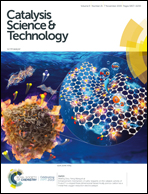Alkaline-earth-metal-doped TiO2 for enhanced photodegradation and H2 evolution: insights into the mechanisms†
Abstract
The doping strategy of TiO2 with an AM (alkali earth metal) for photocatalysis applications has been reported in several literature reports. Nevertheless, the related mechanism has never been fully explained. In the present paper, AM-TiO2-x (AM including Mg, Ca, Sr, and Ba) with a honeycomb-like inverse opal structure was successfully fabricated. The textural and photoelectric properties as well as free radical capture experiments were conducted to explore the mechanism of AM-doping. Before AM-doping, only the ˙OH and holes were active for photodegradation. After AM-doping, both the conduction band (CB) and valence band (VB) of TiO2 were shifted to more negative values, which contributed to the formation of ˙O2−, resulting in photodegradation being significantly promoted. Moreover, the faster carrier separation and transfer efficiency also play an important role in enhancing the photodegradation efficiency. The enhanced carrier separation and transfer efficiency and the more negative reduction potential are also considered to be important factors for enhanced hydrogen production.



 Please wait while we load your content...
Please wait while we load your content...